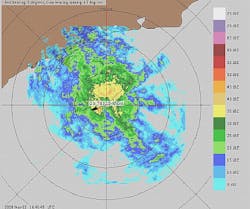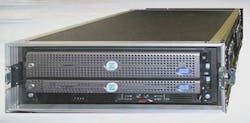Navy looking to BCI to extract weather radar data from tactical ship- and land-based radar systems
SAN DIEGO, 20 March 2015. U.S. Navy weather experts needed a way to extract weather radar information from shipboard and land-based radar systems normally used to detect potentially hostile aircraft and other incoming threats. They found their solution from Basic Commerce & Industries Inc. (BCI) in Moorestown, N.J.
Officials of the Space and Naval Warfare (SPAWAR) Systems Center Pacific in San Diego announced a five-year $10.9 million contract to BCI this week to build, install, and support Weather Radar Through-The-Sensor systems.
Many naval vessels at sea, and military detachments deployed around the globe, often lack organic weather radar information, BCI officials explain. Although satellite sensors and receivers can provide near-real-time weather information, this data often is not continuously available.
Weather Radar Through-The-Sensor involves a real-time adjunct weather processor that converts tactical radar returns into meaningful weather radar information. The passive interface from the radar to the weather extractor computer (WEC) has no bad influences on the tactical operation of the radar, company officials say.
The WEC is based on commercial off-the-shelf (COTS) PC server technology and adheres to the US Navy’s Open Architecture guidelines. Weather information updates come at intervals as frequent as once per minute.
Weather products are available from the WEC via standard Ethernet connection to external networks like IT-21 and ISIS, or via closed-circuit video like 23-TV.
BCI radar experts have developed and tested the WEC for us with the Navy's Exelis AN/SPS-48E 3D passive electronically scanned array air search radar, yet the system can work with other naval radar systems with minor software and radar interface hardware modifications, company officials say.
Engineers at the BCI Sensor Systems segment in Mount Laurel, N.J., are developing WEC variants for the Navy's AN/SPY-1 radar and for the Air Force's TPS-75 radar to enable these radar systems to provide weather radar data as a secondary output from their normal operation.
The BCI Weather Radar Through-The-Sensor weather extractor computer offers standard meteorological radar products; reflectivity, velocity, and spectrum width; wind profiles; echo tops; hydrological products; storm tracking; data quality control; clutter and point target editing; velocity and range unfolding; Windows or Linux software operating systems; web-server display and data distribution; and qualification for SIPRNET tactical networking.
Related: Air Force eyes modeling software to understand how wind farms create radar dead spots
On this contract BCI will do the work in Moorestown, N.J., and in San Diego, and should be finished by March 2020.
For more information contact Basic Commerce & Industries online at www.bcisse.com; BCI Sensor Systems at http://bcisensors.com, or the SPAWAR Systems Center Pacific at www.spawar.navy.mil/sandiego.

John Keller | Editor
John Keller is editor-in-chief of Military & Aerospace Electronics magazine, which provides extensive coverage and analysis of enabling electronic and optoelectronic technologies in military, space, and commercial aviation applications. A member of the Military & Aerospace Electronics staff since the magazine's founding in 1989, Mr. Keller took over as chief editor in 1995.


